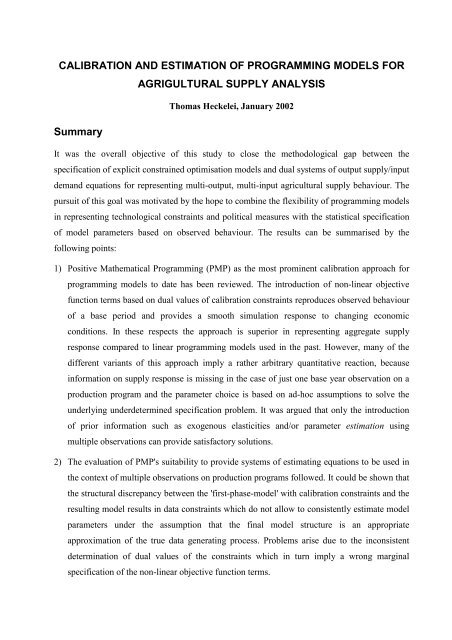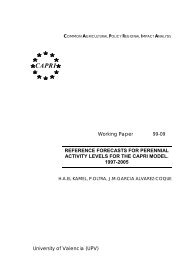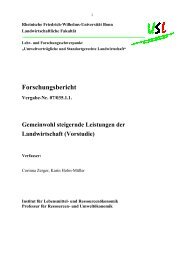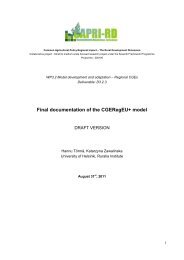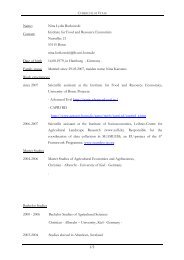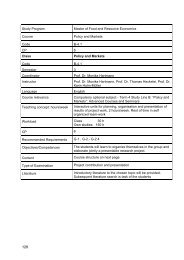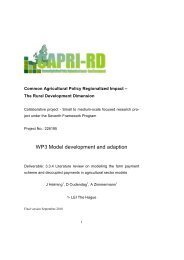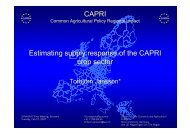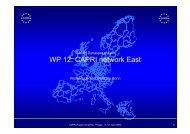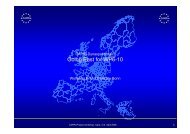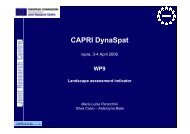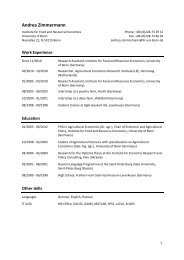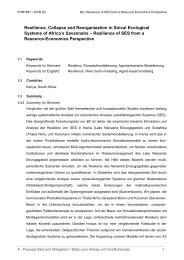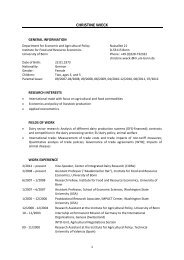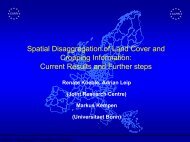Part 1): "Positive Programming Models - Overview on applications in ...
Part 1): "Positive Programming Models - Overview on applications in ...
Part 1): "Positive Programming Models - Overview on applications in ...
Create successful ePaper yourself
Turn your PDF publications into a flip-book with our unique Google optimized e-Paper software.
CALIBRATION AND ESTIMATION OF PROGRAMMING MODELS FOR<br />
AGRIGULTURAL SUPPLY ANALYSIS<br />
Summary<br />
Thomas Heckelei, January 2002<br />
It was the overall objective of this study to close the methodological gap between the<br />
specificati<strong>on</strong> of explicit c<strong>on</strong>stra<strong>in</strong>ed optimisati<strong>on</strong> models and dual systems of output supply/<strong>in</strong>put<br />
demand equati<strong>on</strong>s for represent<strong>in</strong>g multi-output, multi-<strong>in</strong>put agricultural supply behaviour. The<br />
pursuit of this goal was motivated by the hope to comb<strong>in</strong>e the flexibility of programm<strong>in</strong>g models<br />
<strong>in</strong> represent<strong>in</strong>g technological c<strong>on</strong>stra<strong>in</strong>ts and political measures with the statistical specificati<strong>on</strong><br />
of model parameters based <strong>on</strong> observed behaviour. The results can be summarised by the<br />
follow<strong>in</strong>g po<strong>in</strong>ts:<br />
1) <str<strong>on</strong>g>Positive</str<strong>on</strong>g> Mathematical <str<strong>on</strong>g>Programm<strong>in</strong>g</str<strong>on</strong>g> (PMP) as the most prom<strong>in</strong>ent calibrati<strong>on</strong> approach for<br />
programm<strong>in</strong>g models to date has been reviewed. The <strong>in</strong>troducti<strong>on</strong> of n<strong>on</strong>-l<strong>in</strong>ear objective<br />
functi<strong>on</strong> terms based <strong>on</strong> dual values of calibrati<strong>on</strong> c<strong>on</strong>stra<strong>in</strong>ts reproduces observed behaviour<br />
of a base period and provides a smooth simulati<strong>on</strong> resp<strong>on</strong>se to chang<strong>in</strong>g ec<strong>on</strong>omic<br />
c<strong>on</strong>diti<strong>on</strong>s. In these respects the approach is superior <strong>in</strong> represent<strong>in</strong>g aggregate supply<br />
resp<strong>on</strong>se compared to l<strong>in</strong>ear programm<strong>in</strong>g models used <strong>in</strong> the past. However, many of the<br />
different variants of this approach imply a rather arbitrary quantitative reacti<strong>on</strong>, because<br />
<strong>in</strong>formati<strong>on</strong> <strong>on</strong> supply resp<strong>on</strong>se is miss<strong>in</strong>g <strong>in</strong> the case of just <strong>on</strong>e base year observati<strong>on</strong> <strong>on</strong> a<br />
producti<strong>on</strong> program and the parameter choice is based <strong>on</strong> ad-hoc assumpti<strong>on</strong>s to solve the<br />
underly<strong>in</strong>g underdeterm<strong>in</strong>ed specificati<strong>on</strong> problem. It was argued that <strong>on</strong>ly the <strong>in</strong>troducti<strong>on</strong><br />
of prior <strong>in</strong>formati<strong>on</strong> such as exogenous elasticities and/or parameter estimati<strong>on</strong> us<strong>in</strong>g<br />
multiple observati<strong>on</strong>s can provide satisfactory soluti<strong>on</strong>s.<br />
2) The evaluati<strong>on</strong> of PMP's suitability to provide systems of estimat<strong>in</strong>g equati<strong>on</strong>s to be used <strong>in</strong><br />
the c<strong>on</strong>text of multiple observati<strong>on</strong>s <strong>on</strong> producti<strong>on</strong> programs followed. It could be shown that<br />
the structural discrepancy between the 'first-phase-model' with calibrati<strong>on</strong> c<strong>on</strong>stra<strong>in</strong>ts and the<br />
result<strong>in</strong>g model results <strong>in</strong> data c<strong>on</strong>stra<strong>in</strong>ts which do not allow to c<strong>on</strong>sistently estimate model<br />
parameters under the assumpti<strong>on</strong> that the f<strong>in</strong>al model structure is an appropriate<br />
approximati<strong>on</strong> of the true data generat<strong>in</strong>g process. Problems arise due to the <strong>in</strong>c<strong>on</strong>sistent<br />
determ<strong>in</strong>ati<strong>on</strong> of dual values of the c<strong>on</strong>stra<strong>in</strong>ts which <strong>in</strong> turn imply a wr<strong>on</strong>g marg<strong>in</strong>al<br />
specificati<strong>on</strong> of the n<strong>on</strong>-l<strong>in</strong>ear objective functi<strong>on</strong> terms.
3) A simple but general alternative approach to calibrate or estimate programm<strong>in</strong>g models was<br />
<strong>in</strong>troduced which uses first order necessary c<strong>on</strong>diti<strong>on</strong>s derived from the desired model<br />
structure as estimat<strong>in</strong>g equati<strong>on</strong>s. It allows to simultaneously estimate model parameters and<br />
dual values of c<strong>on</strong>stra<strong>in</strong>ts. This approach is not <strong>on</strong>ly suitable for typical PMP models but can<br />
be applied to general programm<strong>in</strong>g model specificati<strong>on</strong>s as well. It has the potential to<br />
provide an equivalent and at the same time more flexible way for estimat<strong>in</strong>g c<strong>on</strong>stra<strong>in</strong>ed<br />
optimisati<strong>on</strong> models compared to traditi<strong>on</strong>al ec<strong>on</strong>ometric approaches based <strong>on</strong> duality<br />
theory.<br />
4) In order to address a further shortcom<strong>in</strong>g of typical PMP applicati<strong>on</strong>s and to derive<br />
corresp<strong>on</strong>d<strong>in</strong>g first order necessary c<strong>on</strong>diti<strong>on</strong>s for estimati<strong>on</strong>, rati<strong>on</strong>alisati<strong>on</strong>s of n<strong>on</strong>-l<strong>in</strong>ear<br />
terms <strong>in</strong> profit maximisati<strong>on</strong> models with Le<strong>on</strong>tief technology were c<strong>on</strong>sidered. The<br />
<strong>in</strong>clusi<strong>on</strong> of crop specific land supply functi<strong>on</strong>s to represent land heterogeneity was shown to<br />
result <strong>in</strong> a programm<strong>in</strong>g model equivalent to PMP models with n<strong>on</strong>-l<strong>in</strong>ear costs <strong>in</strong> activity<br />
levels. A more general look at the underly<strong>in</strong>g aggregati<strong>on</strong> problem if the distributi<strong>on</strong> of land<br />
qualities is not available lead to a variant of 'c<strong>on</strong>vex comb<strong>in</strong>ati<strong>on</strong> c<strong>on</strong>stra<strong>in</strong>ts' where a fr<strong>on</strong>tier<br />
of extreme po<strong>in</strong>ts is approximated by a n<strong>on</strong>-l<strong>in</strong>ear c<strong>on</strong>stra<strong>in</strong>t. The same specificati<strong>on</strong> can be<br />
<strong>in</strong>terpreted as represent<strong>in</strong>g an unknown 'operat<strong>in</strong>g capacity' c<strong>on</strong>stra<strong>in</strong>t.<br />
5) To show the applicability of the estimati<strong>on</strong> pr<strong>in</strong>ciple to model structures underly<strong>in</strong>g previous<br />
ec<strong>on</strong>ometric estimati<strong>on</strong>s of behavioural functi<strong>on</strong>s, fully rati<strong>on</strong>alised profit maximisati<strong>on</strong><br />
models under general technologies with allocati<strong>on</strong> of the fixed factor land were exam<strong>in</strong>ed. In<br />
the c<strong>on</strong>text of crop specific technologies, three equivalent models provide the possibility to<br />
alternatively estimate the parameters of profit-, cost- or producti<strong>on</strong> functi<strong>on</strong>s for each crop<br />
simultaneously while ma<strong>in</strong>ta<strong>in</strong><strong>in</strong>g the assumed optimisati<strong>on</strong> structure dur<strong>in</strong>g estimati<strong>on</strong>. Two<br />
extensi<strong>on</strong>s illustrated the generalisati<strong>on</strong> to jo<strong>in</strong>t <strong>in</strong>puts <strong>in</strong> a multi-output framework and to<br />
explicitly <strong>in</strong>corporate risk behaviour of agricultural producers <strong>in</strong> an expected utility<br />
maximisati<strong>on</strong> model. These derivati<strong>on</strong>s laid the ground to estimate structural parameters of<br />
programm<strong>in</strong>g models theoretically equivalent to the estimati<strong>on</strong> of behavioural functi<strong>on</strong>s<br />
based <strong>on</strong> duality theory, but with the possibility to ma<strong>in</strong>ta<strong>in</strong> more complex c<strong>on</strong>stra<strong>in</strong>ed<br />
optimisati<strong>on</strong> structures that do not allow closed form soluti<strong>on</strong>s for <strong>in</strong>put demand and output<br />
supply equati<strong>on</strong>s.<br />
6) Exemplary applicati<strong>on</strong>s of the specificati<strong>on</strong> approach dem<strong>on</strong>strated its functi<strong>on</strong>ality by<br />
evaluat<strong>in</strong>g estimati<strong>on</strong> exercises based <strong>on</strong> multiple observati<strong>on</strong>s with M<strong>on</strong>te Carlo<br />
simulati<strong>on</strong>s. The 'Data c<strong>on</strong>stra<strong>in</strong>ed Generalised Maximum Entropy' approach (GME-D) was
eviewed and employed as an estimati<strong>on</strong> pr<strong>in</strong>ciple which allows to encompass situati<strong>on</strong>s with<br />
negative ('ill-posed') and positive ('well-posed') degrees of freedom. M<strong>on</strong>te Carlo simulati<strong>on</strong><br />
results for three different programm<strong>in</strong>g model structures, estimat<strong>in</strong>g parameters of a cost<br />
functi<strong>on</strong>, crop specific producti<strong>on</strong> functi<strong>on</strong>s, and crop specific profit functi<strong>on</strong>s <strong>in</strong>dicate<br />
c<strong>on</strong>sistent behaviour of the estimator <strong>in</strong> this c<strong>on</strong>text. The approach also proved its capability<br />
of estimat<strong>in</strong>g model parameters across b<strong>in</strong>d<strong>in</strong>g and n<strong>on</strong>-b<strong>in</strong>d<strong>in</strong>g <strong>in</strong>equality c<strong>on</strong>stra<strong>in</strong>ts <strong>in</strong> the<br />
data generati<strong>on</strong> process.<br />
7) The GME-D approach also allows to address the problem of limited data <strong>in</strong>formati<strong>on</strong> which<br />
often prevails <strong>in</strong> the c<strong>on</strong>text of differentiated, large scale modell<strong>in</strong>g exercises. The <strong>in</strong>clusi<strong>on</strong><br />
of prior <strong>in</strong>formati<strong>on</strong> <strong>in</strong> the form of supply elasticities and shadow prices of fixed resources<br />
was dem<strong>on</strong>strated and shown to improve small sample estimati<strong>on</strong> accuracy. The employed<br />
reparameterisati<strong>on</strong> of 'functi<strong>on</strong>s of parameters' is a very useful extensi<strong>on</strong> of previous GME-D<br />
applicati<strong>on</strong>s that is closer to empirically relevant types of prior <strong>in</strong>formati<strong>on</strong>. For <strong>on</strong>e of the<br />
exemplatory programm<strong>in</strong>g models successful calibrati<strong>on</strong>s to base year observati<strong>on</strong>s were<br />
provided with different variants of prior <strong>in</strong>formati<strong>on</strong> <strong>on</strong> supply elasticities. This approach<br />
relies <strong>on</strong> the same data c<strong>on</strong>stra<strong>in</strong>ts and generally allows to employ the same GME-D<br />
formalism as for well posed situati<strong>on</strong>s.<br />
8) The f<strong>in</strong>al chapter of the study puts the estimati<strong>on</strong> of programm<strong>in</strong>g models <strong>in</strong>to the c<strong>on</strong>text of<br />
the large scale policy <strong>in</strong>formati<strong>on</strong> system CAPRI. Results of an explorative applicati<strong>on</strong> of<br />
this modell<strong>in</strong>g system to evaluate agricultural policy changes <strong>in</strong> the 'grandes cultures' and<br />
beef sector implied by Agenda 2000 were presented. The modell<strong>in</strong>g system comb<strong>in</strong>es EUwide<br />
full coverage of the agricultural sector with a regi<strong>on</strong>al differentiated representati<strong>on</strong> of<br />
agricultural producti<strong>on</strong>. Regi<strong>on</strong>al programm<strong>in</strong>g models allow to closely implement major<br />
policy measures of the CAP <strong>on</strong> the supply side. The <strong>in</strong>tegrati<strong>on</strong> with commodity markets at<br />
member state, EU and world level <strong>in</strong>clud<strong>in</strong>g relevant trade policy measures is realised by an<br />
iterative market clear<strong>in</strong>g process. CAPRI thereby offers a comprehensive tool for the<br />
evaluati<strong>on</strong> of EU agricultural policy programs. In additi<strong>on</strong>, l<strong>in</strong>ks to envir<strong>on</strong>mental <strong>in</strong>dicators<br />
carry the analysis bey<strong>on</strong>d the evaluati<strong>on</strong> of effects related to agricultural commodities<br />
typically performed with agricultural sector models.<br />
9) The specificati<strong>on</strong> of n<strong>on</strong>-l<strong>in</strong>ear cost functi<strong>on</strong>s for CAPRI's regi<strong>on</strong>al programm<strong>in</strong>g models<br />
received special attenti<strong>on</strong>. The approach can be characterised as an applicati<strong>on</strong> of PMP to<br />
multiple observati<strong>on</strong>s. The suggested methodology is designed to exploit <strong>in</strong>formati<strong>on</strong><br />
c<strong>on</strong>ta<strong>in</strong>ed <strong>in</strong> a cross secti<strong>on</strong>al sample to specify - regi<strong>on</strong>ally specific - quadratic cost
functi<strong>on</strong>s with cross effects for crop activities. It c<strong>on</strong>stitutes the first applicati<strong>on</strong> of PMP to<br />
multiple observati<strong>on</strong>s and also provides a soluti<strong>on</strong> to the 'curvature problem' with respect to<br />
the n<strong>on</strong>-l<strong>in</strong>ear objective functi<strong>on</strong>s. The approach is applied to regi<strong>on</strong>al programm<strong>in</strong>g models<br />
for 22 regi<strong>on</strong>s <strong>in</strong> France. An ex-post simulati<strong>on</strong> across the 1992 reform of the Comm<strong>on</strong><br />
Agricultural Policy shows plausible results with respect to the simulati<strong>on</strong> behaviour of the<br />
result<strong>in</strong>g models, especially compared to a previously employed alternative PMP approach.<br />
A critical evaluati<strong>on</strong> of the estimati<strong>on</strong> methodology <strong>in</strong> light of the theoretical and<br />
methodological f<strong>in</strong>d<strong>in</strong>gs from the other parts of the study is given. This discussi<strong>on</strong> po<strong>in</strong>ts at<br />
extensi<strong>on</strong>s and improvements to be expected from the 'post PMP' approach to the estimati<strong>on</strong><br />
of programm<strong>in</strong>g models developed <strong>in</strong> this study.<br />
We can c<strong>on</strong>clude that the research was successful <strong>in</strong> provid<strong>in</strong>g theoretical and methodological<br />
groundwork for the estimati<strong>on</strong> of programm<strong>in</strong>g models for agricultural supply analysis. It<br />
presented a framework which expanded the 'tool box' of the ec<strong>on</strong>omic analyst, especially with<br />
respect to the specificati<strong>on</strong> of more complex supply specificati<strong>on</strong>s based <strong>on</strong> explicit c<strong>on</strong>stra<strong>in</strong>ed<br />
optimisati<strong>on</strong> hypotheses. The parameters of these models can be quantified based <strong>on</strong> observed<br />
supply behaviour with statistical techniques.<br />
References<br />
HECKELEI, T.(1997): <str<strong>on</strong>g>Positive</str<strong>on</strong>g> Mathematical <str<strong>on</strong>g>Programm<strong>in</strong>g</str<strong>on</strong>g>: Review of the Standard Approach.<br />
CAPRI-work<strong>in</strong>g paper 97-03, University of B<strong>on</strong>n.<br />
HECKELEI T. and W. BRITZ (2000): <str<strong>on</strong>g>Positive</str<strong>on</strong>g> Mathematical <str<strong>on</strong>g>Programm<strong>in</strong>g</str<strong>on</strong>g> with Multiple Data<br />
Po<strong>in</strong>ts: A Cross-Secti<strong>on</strong>al Estimati<strong>on</strong> Procedure. Cahiers d'ec<strong>on</strong>omie et sociologie rurales 57:<br />
28-50.<br />
HECKELEI, T. and W. BRITZ (2001): C<strong>on</strong>cept and Explorative Applicati<strong>on</strong> of an EU-wide<br />
Regi<strong>on</strong>al Agricultural Sector Model (CAPRI-Project). In: Heckelei, T., H.P. Witzke, and W.<br />
Henrichsmeyer (Eds.): Agricultural Sector Modell<strong>in</strong>g and Policy Informati<strong>on</strong> Systems.<br />
Proceed<strong>in</strong>gs of the 65 th EAAE Sem<strong>in</strong>ar, March 29-31, 2000 at B<strong>on</strong>n University, Vauk Verlag<br />
Kiel, pp. 281-290.<br />
HECKELEI, T. and H. WOLFF (2001): A Methodological Note <strong>on</strong> the Estimati<strong>on</strong> of <str<strong>on</strong>g>Programm<strong>in</strong>g</str<strong>on</strong>g><br />
<str<strong>on</strong>g>Models</str<strong>on</strong>g>. Technical Work<strong>in</strong>g Paper 104 of the Internati<strong>on</strong>al Market<strong>in</strong>g Program for<br />
Agricultural Commodities & Trade (IMPACT), Wash<strong>in</strong>gt<strong>on</strong> State University, Pullman.


